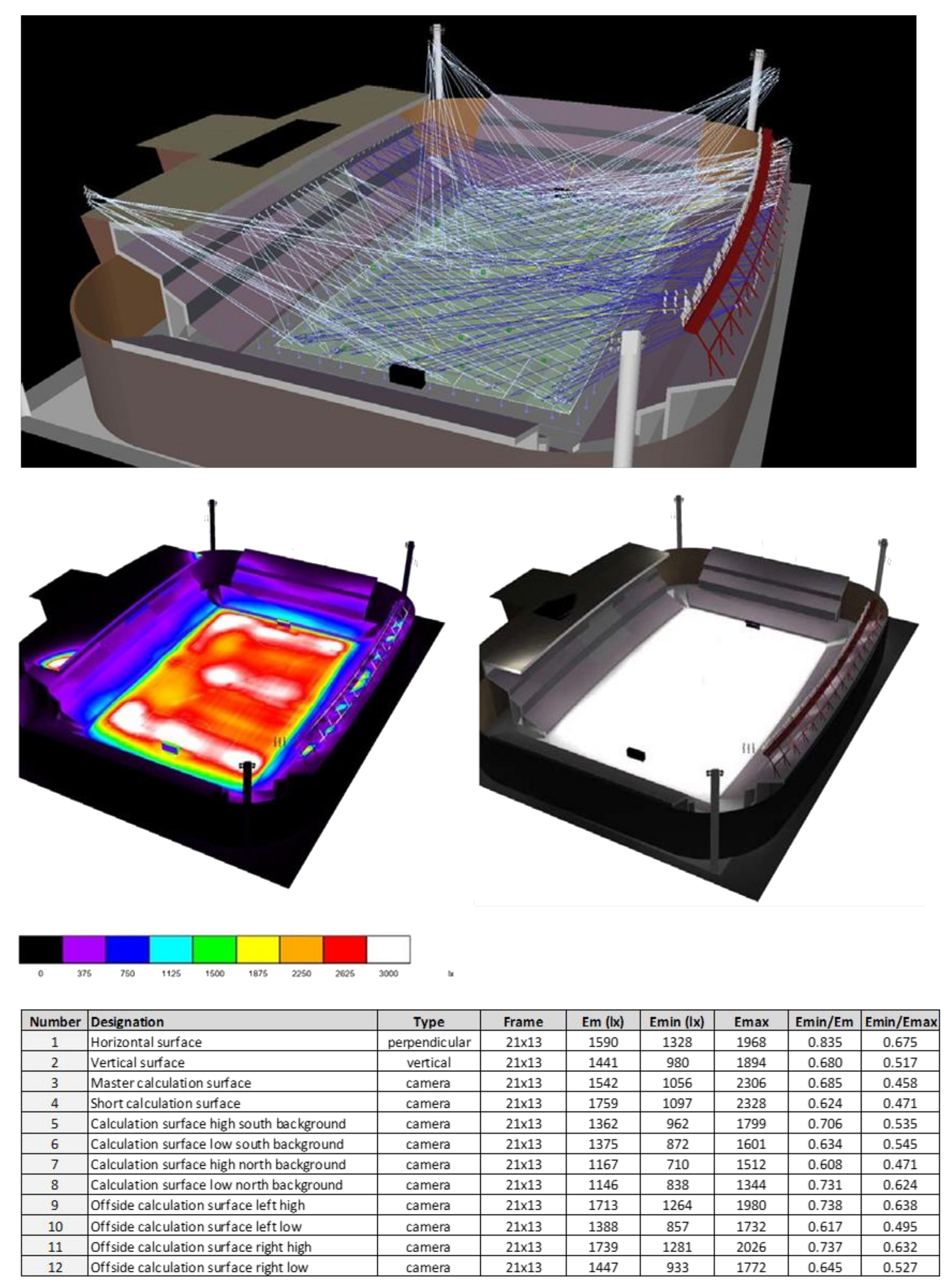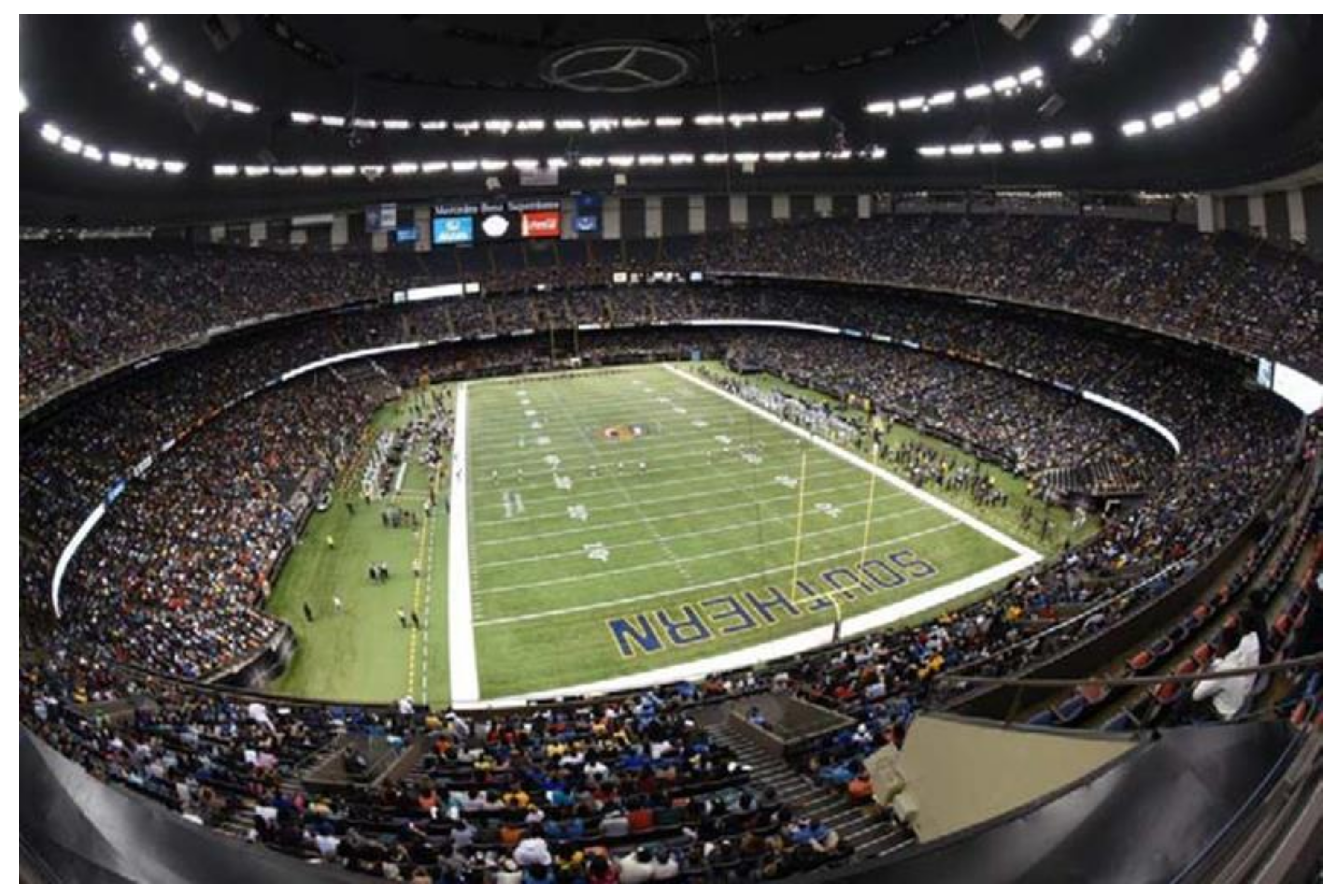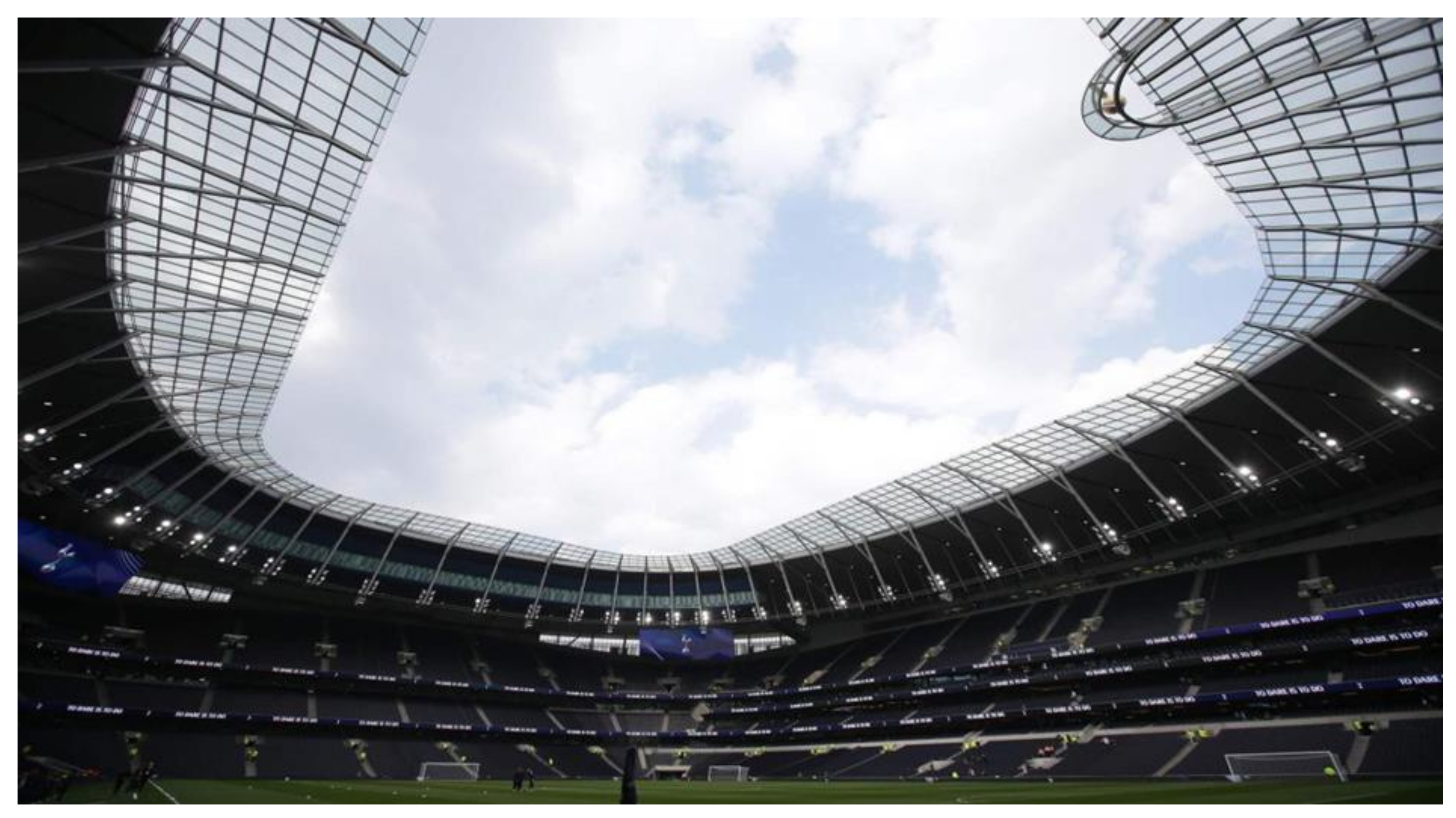LED Lighting Installations in Professional Stadiums: Energy Efficiency, Visual Comfort, and Requirements of 4K TV Broadcast
Abstract
:1. Introduction
2. Materials and Methods
2.1. Lighting Requirements for Football Television Broadcasts
2.2. Location of TV Cameras in Stadiums
2.3. Renovation of the Lighting Installations of Football Stadiums in Spain
2.4. Distribution of Television Rights in Spain
3. Results of Practical Case Studies Performed by the Authors of This Paper
3.1. Lighting of Football Fields Where Non-Televised Events Will Take Place
3.2. Televised Events, Second Spanish Division: New Los Cármenes Stadium
3.3. Retransmissions in 4K, Spanish First Division: Benito Villamarín Stadium
3.4. Retransmissions in 4K, Spanish First Division: Ramón Sánchez Pizjuán Stadium
3.5. Reference Football Stadiums
4. Conclusions
Author Contributions
Funding
Conflicts of Interest
References
- Solberg, H.; Helland, K. Sports broadcasting.An accelerator of business integration in the media industry. Nord. Rev. 2011, 32, 17–33. [Google Scholar] [CrossRef] [Green Version]
- Mohr, I. Super Bowl: A case study of buzz marketing. Int. J. Sports Mark. Spons. 2007, 9, 33–39. [Google Scholar] [CrossRef]
- Kucharski, M.; Kot, S. Cost of recognisability of a sponsor’s brand achieved through TV broadcasts. Oeconomia Copernic. 2017, 8, 447–461. [Google Scholar] [CrossRef]
- Solberg, H. The auctioning of TV sports rights. Int. J. Sport Financ. 2006, 1, 33–45. [Google Scholar]
- Cho, K.; Chin, J. A Study on strategies for ameliorating annual advertisement sales system for TV sports programs. Korean J. Sport Stud. 2004, 43, 385–398. [Google Scholar]
- Rhee, S.-H. Globalization of football and identity politics. Rev. Asiat. Estud. Iberoam. 2006, 17, 91–114. [Google Scholar]
- Na, J.-K. A Study on stage lighting changes and trends of K-Pop ranking program-focusing on three terrestrial channels K-Pop ranking program from 1990s up to recently. Treatise Plast. Media 2014, 17, 71–80. [Google Scholar]
- Choi, H. Illuminance distribution analysis by lighting tower position of a soccer stadium. J. Korean Inst. Illum. Electr. Install. Eng. 2004, 18, 1–8. [Google Scholar]
- Damasceno, N.; Damasceno, E.d.F. Refraction and visual fatigue syndrome on watching the ULTRA HD 4k television curved screen system. Rev. Bras. Oftalmol. 2016, 75, 314–319. [Google Scholar] [CrossRef] [Green Version]
- Xu, J.; Tasaka, K. Keep your eye on the ball: Detection of kicking motions in multi-view 4K Soccer Videos. ITE Trans. Media Technol. Appl. 2020, 8, 81–88. [Google Scholar] [CrossRef] [Green Version]
- Sang-IL, K.; CHUL, K.S.; Seung-Hyun, L.; Hamacher, A. A study on the utilization of 4K/UHD camera with 2/3” sensor: Focused on application of HD lens. J. Digit. Contents Soc. 2015, 16, 227–234. [Google Scholar] [CrossRef]
- Gago-Calderón, A.; Hermoso-Orzáez, M.J.; De Andres-Diaz, J.R.; Redrado-Salvatierra, G. Evaluation of uniformity and glare improvement with low energy efficiency losses in street lighting LED luminaires using laser-sintered polyamide-based diffuse covers. Energies 2018, 11, 816. [Google Scholar] [CrossRef] [Green Version]
- Pattison, P.; Hansen, M.; Tsao, J.Y. LED lighting efficacy: Status and directions. Comptes Rendus Phys. 2018, 19, 134–145. [Google Scholar] [CrossRef]
- Gilbert, H. Introduction to Light Emitting Diode Technology and Applications, 1st ed.; Francis, T., Ed.; Auerbach Publications: New York, NY, USA, 2009; ISBN 9780429133848. [Google Scholar]
- Ahn, D.H.; Kim, S.W.; Lee, H.; Ko, I.J.; Karthik, D.; Lee, J.Y.; Kwon, J.H. Highly efficient blue thermally activated delayed fluorescence emitters based on symmetrical and rigid oxygen-bridged boron acceptors. Nat. Photonics 2019, 13, 540–546. [Google Scholar] [CrossRef]
- Wu, T.L.; Huang, M.J.; Lin, C.C.; Huang, P.Y.; Chou, T.Y.; Chen-Cheng, R.W.; Lin, H.W.; Liu, R.S.; Cheng, C.H. Diboron compound-based organic light-emitting diodes with high efficiency and reduced efficiency roll-off. Nat. Photonics 2018, 12, 235–240. [Google Scholar] [CrossRef]
- Yang, W.Z.; Lai, H.-Y.; Lee, W.-K.; Jiao, M.; Shiu, Y.-J.; Zhong, C.; Gong, S.; Zhou, T.; Xie, G.; Sarma, M.; et al. Achieving nearly 30% external quantum efficiency for orange–red organic light emitting diodes by employing thermally activated delayed fluorescence emitters composed of 1,8-naphthalimide-acridine hybrids. Adv. Mater. 2017, 1. [Google Scholar] [CrossRef]
- Dong, Y.; Wang, Y.K.; Yuan, F.; Johnston, A.; Liu, Y.; Ma, D.; Choi, M.J.; Chen, B.; Chekini, M.; Baek, S.W.; et al. Bipolar-shell resurfacing for blue LEDs based on strongly confined perovskite quantum dots. Nat. Nanotechnol. 2020, 15, 668–674. [Google Scholar] [CrossRef]
- Keshtov, M.L.; Kuklin, S.A.; Buzin, M.I.; Godovsky, D.Y.; Khokhlov, A.R. High efficiency colloidal quantum dot infrared light emitting diodes via engineering at the supra-nanocrystalline level. Acad. Sci. 2016, 469, 319–323. [Google Scholar]
- Vasilopoulou, M.; Kim, H.P.; Kim, B.S.; Papadakis, M.; Ximim Gavim, A.E.; Macedo, A.G.; Jose da Silva, W.; Schneider, F.K.; Mat Teridi, M.A.; Coutsolelos, A.G.; et al. Efficient colloidal quantum dot light-emitting diodes operating in the second near-infrared biological window. Nat. Photonics 2020, 14, 50–56. [Google Scholar] [CrossRef]
- Rhee, S.; Kim, K.; Roh, J.; Kwak, J. Recent progress in high-luminance quantum dot light-emitting diodes. Curr. Opt. Photonics 2020, 4, 161–173. [Google Scholar]
- Mou, X.; Freyssinier, J.P.; Narendran, N.; Bullough, J.D. Preliminary evaluation of discomfort glare from organic light-emitting diode and edge-lit light-emitting diode lighting panels. J. Biomed. Opt. 2017, 22, 55004. [Google Scholar] [CrossRef] [PubMed]
- Supran, G.J.; Shirasaki, Y.; Song, K.W.; Caruge, J.M.; Kazlas, P.T.; Coe-Sullivan, S.; Andrew, T.L.; Bawendi, M.G.; Bulović, V. QLEDs for displays and solid-state lighting. Mrs Bull. 2013, 38, 703–711. [Google Scholar] [CrossRef]
- Fernandes, L.; Bhavani, R. Comparative performance evaluation and assessment of organic light emitting diodes and light emitting diodes. In Proceedings of the 2016 IEEE 59th International Midwest Symposium on Circuits and Systems (MWSCAS), Abu Dhabi, UAE, 16−19 October 2016; pp. 593–596. [Google Scholar]
- Pode, R. Organic light emitting diode devices: An energy efficient solid state lighting for applications. Renew. Sustain. Energy Rev. 2020, 133, 110043. [Google Scholar] [CrossRef]
- Fraile-Villarrasa, J.; Gago-Calderon, A. Lighting with Led Technology, 1st ed.; Paraninfo, Ed.; Ediciones Paraninfo S.A: Madrid, Spain, 2012; ISBN 9788428333689. [Google Scholar]
- Musumeci, S.; Bojoi, R.; Armando, E.; Borlo, S.; Mandrile, F. Three-legs interleaved boost power factor corrector for high-power LED lighting application. Energies 2020, 13, 1728. [Google Scholar] [CrossRef] [Green Version]
- Botta, C.R.; DelMont, R.; Reddy, R. Stadiums Soccer Recommendations Techniques and Requirements, 5th ed.; Fédération Internationale de Football Association: Zúrich, Switzerland, 2011. [Google Scholar]
- Criado-Contreras, A. Regulations for Television Broadcast of the National Football League Professional; Spain. 2018. Available online: https://files.laliga.es/descargables/reglament (accessed on 2 April 2019).
- League, P. Premier League Handbook Season 2018/2019. Available online: https://www.premierleague.com/publications (accessed on 4 April 2018).
- UEFA. UEFA Stadium Lighting Guide 2016. Available online: https://www.uefa.com/MultimediaFiles/Download/uefaorg/General/02/36/26/72/2362672_DOWNLOAD.pdf (accessed on 4 April 2019).
- Football NSW. Football Lighting: A Guide to Effective Sports Lighting for Football. Meurants Lane Glenwood NSW. 2015. Available online: https://footballfacilities.com.au/football-lighting/Gago (accessed on 2 April 2019).
- Lemons, T.M.; Rosen, S.; Gernetzke, C.; Lussier, B. United States Patent. No. US8998449B1. No. US8998449B1, 2015. Available online: https://www.uspto.gov/patent (accessed on 2 April 2019).
- International electrotechnical Comision IEC 60050-161:1990. International Electrotechnical Vocabulary (IEV)-Part. 161: Electromagnetic Compatibility. 1990. Available online: https://webstore.iec.ch/publication/181 (accessed on 2 April 2019).
- Gil-de-castro, A.; Rönnberg, S.K.; Bollen, M.H.J. Light intensity variation (flicker) and harmonic emission related to LED lamps. Electr. Power Syst. Res. 2017, 146, 107–114. [Google Scholar] [CrossRef]
- Gutierrez, J.J.; Saiz, P.; Azcarate, I.; Leturiondo, L.A.; Redondo, K.; Gauna, S.R.; De Gonzalez-otero, D.M. Electrical power and energy systems sensitivity of modern lighting technologies at varying flicker severity levels. Int. J. Electr. Power Energy Syst. 2017, 92, 34–41. [Google Scholar] [CrossRef]
- LaLiga. The Nuevo Los Carmenes and the Riazor- the Battlegrounds for the Liga BBVA Title.Liga de Fútbol Profesional. Available online: https://www.laliga.es/en/news/the-nuevo-los-carmenes-and-the-raizor-the-battlegrounds-for-the-liga-bbva-title (accessed on 2 April 2019).
- Congresotec. New lighting technologies in soccer stadiums. Proceedings of the Congreso Nacional de Eficiencia Energética Y Sostenibilidad en Instalaciones Deportivas, Palma, Spain, 19–20 April 2018. Available online: https://congresotec.es/wp-content/uploads/2018/05/17.-retransmision-LA-LIGA.pdf.Congresotec (accessed on 2 April 2019).
- Goverment of Spain. Royal Decree-Law 5/2015, of 30 April, On Urgent Measures in Relation to the Commercialization of the Exploitation Rights of Audiovisual Content of Professional Football Competitions. 2015. Available online: https://www.boe.es/diario_boe/txt.php?id=BOE-A-201 (accessed on 2 April 2019).
- KPMG International. Socio-Economic Impact of Professional Football in Spain (p. 26). Available online: https://assets.kpmg/content/dam/kpmg/pdf/2015/06/impacto-socio-economico-futbol-profesional-Espana.pdf (accessed on 2 April 2019).
- Laliga. The Professional Football Industry Generates 185,000 Jobs, € 4,100 M in Taxes and a Turnover Equivalent to 1.37% of GDP in Spain. 2019. Available online: https://www.laliga.es/noticias/la-industria-del-futbol-profesional-genera-185-000-empleos-4-100-me-en-impuestos-y-una- (accessed on 2 April 2019).
- PWC. Economic, Fiscal and Social Impact of Professional Football in Spain. 2018. Available online: https://files.laliga.es/201902/28181426impacto-econ--mico--fiscal-y-social-del-f--tbol-pr.pdf (accessed on 2 April 2019).
- Laliga. Bases for the Request of Offers for the Commer Cialization of the Rights of Exploitation of Audiovisual Contents of the National Championship of League of First and Second Division for the seasons 2019/2020 to 2021/2022; LaLiga: Madrid, Spain, 2018. [Google Scholar]
- Laliga. Informative Note; Laliga: Madrid, Spain, 2018; Available online: https://www.laliga.es/noticias/nota-informativa-evolucion-del-proceso-de-solicitud-de-ofertas-para-la-comercializacion-de-los-derechos-de-explotacion-de-contenidos-audiovisuales-para-las-temporadas-20192020-a-20212022 (accessed on 2 April 2019).
- Laliga. Distribution of Audiovisual Income in Compliance with the Obligations Set Forth in Royal Decree-Law 5/2015; Laliga: Madrid, Spain, 2015; Available online: https://www.laliga.es/lfp/reparto-ingresos-audiovisuales (accessed on 2 April 2019).
- Laliga. Ten Things You May Not Have Known about Nuevo Los Cármenes; Laliga: Madrid, Spain, 2015; Available online: https://www.laliga.es/noticias/diez-cosas-que-quiza-no-sabias-del-nuevo-los-carmenes (accessed on 2 April 2019).
- Real Betis Balompié. Benito Villamarín Stadium-Real Betis Balompié. Available online: https://www.realbetisbalompie.es/club/estadio-benito-villamarin/ (accessed on 2 April 2019).
- Sevila C.F. Ramón Sánchez-Pizjuán Stadium | Sevilla FC. Available online: https://www.sevillafc.es/el-club/ramon-sanchez-pizjuan (accessed on 2 April 2019).
- Athletic Club. The San Mamés Stadium: The Cathedral | Official Athletic Club. Available online: https://www.athletic-club.eus/san-mames/el-estadio (accessed on 2 April 2019).
- Atletico de Madrid CF. Club Atlético de Madrid-The Wanda Metropolitano, A Unique Experience. Available online: https://www.atleticodemadrid.com/galerias/wanda-metropolitano-3?cat=nuevo-estadio (accessed on 2 April 2019).
- 14 Photos. Tottenham Stadium, An Architectural “Gem”. El Pais. 2019. Available online: https://elpais.com/elpais/2019/04/03/album/1554291 (accessed on 2 April 2019).
- The Last “Jewel in the Crown”: The Tottenham Hotspur Stadium; La Vanguardia 2019. Available online: https://www.lavanguardia.com/deportes/20190403/461 (accessed on 2 April 2019).
- Mercedes-Benz. Mercedes-Benz Stadium. Available online: https://mercedesbenzstadium.com/the-stadium/ (accessed on 2 April 2019).
- Federation International Amateur Football. FIFA 2018. World Cup RussiaTM. Available online: http://es.fifa.com/worldcup/destination/stadiums/stadium=5000569/index.html (accessed on 2 April 2019).
















| Football Control Bodies in Different Competitions and Territorial Areas | LALIGA (Spain) First Division 2016 | PREMIER LEAGUE (England) First Division 2018 | UEFA (Europe) Elite Stadiums Level A 2016 | FIFA (Worldwide) International Class V 2011 | |
|---|---|---|---|---|---|
| Vertical Illuminance | Vertical Illuminance: (Lux) | 2200 | 1650 | 1500 | 2000 |
| Directed to fixed cameras | Uniformity 1: (Emin/Emax) | 0.6 | 0.5 | 0.4 | 0.6 |
| Uniformity2: (Emin/Em) | 0.7 | 0.6 | 0.5 | 0.7 | |
| Horizontal illuminance | Horizontal Illuminance (Lux) | 3000 | - | 2000 | 3500 |
| (Measured at the playing field level) | Uniformity 1: (Emin/Emax) | 0.7 | - | 0.5 | 0.6 |
| Uniformity 2: (Emin/Em) | 0.8 | - | 0.7 | 0.8 | |
| Correlated Color Temperature (K) | 5000 −6200 | 5200 −6000 | 5500 −6200 | >4000 | |
| Color Rendering (RA/CRI) | ≥90 | ≥80 | ≥80 | ≥65 | |
| Glare (GR) | ≤50 | ≤50 | <50 | ≤50 | |
| Flicker (FF) | <5% | <6% | <5% | <5% | |
© 2020 by the authors. Licensee MDPI, Basel, Switzerland. This article is an open access article distributed under the terms and conditions of the Creative Commons Attribution (CC BY) license (http://creativecommons.org/licenses/by/4.0/).
Share and Cite
Orejón-Sánchez, R.D.; Hermoso-Orzáez, M.J.; Gago-Calderón, A. LED Lighting Installations in Professional Stadiums: Energy Efficiency, Visual Comfort, and Requirements of 4K TV Broadcast. Sustainability 2020, 12, 7684. https://doi.org/10.3390/su12187684
Orejón-Sánchez RD, Hermoso-Orzáez MJ, Gago-Calderón A. LED Lighting Installations in Professional Stadiums: Energy Efficiency, Visual Comfort, and Requirements of 4K TV Broadcast. Sustainability. 2020; 12(18):7684. https://doi.org/10.3390/su12187684
Chicago/Turabian StyleOrejón-Sánchez, Rami David, Manuel Jesús Hermoso-Orzáez, and Alfonso Gago-Calderón. 2020. "LED Lighting Installations in Professional Stadiums: Energy Efficiency, Visual Comfort, and Requirements of 4K TV Broadcast" Sustainability 12, no. 18: 7684. https://doi.org/10.3390/su12187684
APA StyleOrejón-Sánchez, R. D., Hermoso-Orzáez, M. J., & Gago-Calderón, A. (2020). LED Lighting Installations in Professional Stadiums: Energy Efficiency, Visual Comfort, and Requirements of 4K TV Broadcast. Sustainability, 12(18), 7684. https://doi.org/10.3390/su12187684







